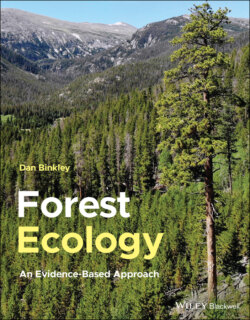Читать книгу Forest Ecology - Dan Binkley - Страница 24
Trees Grow and Reproduce at Times Scales of a Century
ОглавлениеTulip poplar trees originate from seeds that develop following pollination of a flower by a bee or other insect. The flower may have developed on a parent tree as young as one or two decades, or as old as one or two centuries. Seeds develop over a period of five or six months, and then fall to the ground within a radius equal to a few times the height of the parent tree. A single seed may germinate the following summer, or several summers later. The vast majority of seeds may never germinate, or if they germinate may not lead to a successfully established seedling. New seedlings require a great deal of luck to establish, including obtaining enough water and nutrients from the soil to support the development of leaves, and enough sunlight (perhaps 10% of full sun) to drive photosynthesis. The full intensity of sunlight may dry out a seedling, or overwhelm the photochemistry of new leaves.
FIGURE 1.3 Seasonal trends in incoming sunlight (A) lead to almost twofold differences between summer and winter. The difference might be larger if not for the frequent cloud cover in summer. Patterns in incoming light lead to both daily and seasonal patterns in air temperatures (B). These environmental driving forces combine with the biology of the tulip poplar to determine the seasonal course of water use by the tree (C).
Source: Data from Chelcy Miniat.
FIGURE 1.4 Growth of yellow poplar trees is low in drier summers (a negative value for the Palmer Drought Severity index), and increases with increasing summer moisture.
Source: Data from Kardol et al. 2010.
A tulip poplar stem may not be the “first generation” of the “tree.” A tree stem may die (from a wind storm breaking the stem, or a saw harvesting the tree), and a new stem may develop from dormant buds in the stump. The early growth and development of sprouted stems is faster and more assured than the tenuous development of a new seedling.
Weather differs a lot from one year to the next, and the growth of the tree during favorable periods may be double the growth rate for droughtier times (Figure 1.4). This response of an individual tree is the outcome of several factors, including the direct effects of the environment on this tree's physiology, and the indirect effects of how fluctuations in the environment change the competition between trees in the forest.
The tree is larger than its local neighbors, and this “dominance” provides a twofold advantage. The tree obtains a higher supply of light, water, and nutrients than its neighbors, driving faster growth. Faster growth then leads to a positive feedback that increases the tree's capture of resources, allowing its growth to increase at the expense of neighbors.
